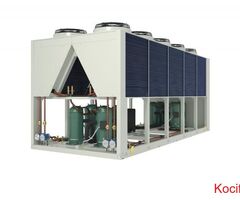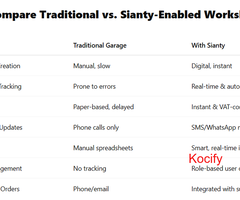The Evolution of Food Service Equipment: How Technology is Reshaping Commercial Kitchens
The food service industry has undergone a remarkable transformation over the past century, driven by technological advancements and changing consumer demands. From traditional cooking methods to the integration of smart technology, food service equipment has evolved to enhance efficiency, consistency, and sustainability in commercial kitchens. The rapid pace of innovation continues to reshape how restaurants, cafeterias, and food production facilities operate, setting new standards for food safety, energy efficiency, and automation.
According to a Food Service Equipment Market report, the industry is expected to grow significantly in the coming years.
Early Innovations in Food Service Equipment
The history of food service equipment dates back to rudimentary cooking tools used in open-fire cooking, with advancements occurring gradually over time. The introduction of cast iron stoves in the 18th century allowed for better heat control, revolutionizing cooking methods. By the early 20th century, commercial-grade ovens, refrigeration units, and dishwashing machines began appearing in restaurant kitchens, streamlining food preparation and storage.
More Info; https://www.marketresearchfuture.com/reports/food-service-equipment-market-3776
Gas and electric stoves replaced wood and coal-burning ranges, improving cooking precision and cleanliness. Mechanical slicers and grinders emerged, reducing manual labor and increasing food production efficiency. These early innovations laid the foundation for the modern food service industry, enabling chefs and restaurateurs to prepare meals more quickly and consistently.
The Rise of Automation and Efficiency
The mid-20th century saw a boom in the fast-food industry, leading to the demand for more efficient kitchen equipment. Conveyor belt cooking systems, deep fryers with automated timers, and high-speed ovens became standard in quick-service restaurants. The introduction of stainless steel surfaces improved hygiene, making kitchen cleaning and maintenance easier.
Advancements in refrigeration technology allowed for better food preservation, reducing waste and improving inventory management. Commercial dishwashers with high-temperature sanitization became essential for maintaining food safety standards. As restaurant chains expanded, the need for standardized cooking processes led to the development of programmable cooking equipment, ensuring consistency across multiple locations.
The Digital Revolution in Commercial Kitchens
The 21st century brought a wave of digital transformation to the food service industry. Smart kitchen equipment integrated with the Internet of Things (IoT) has revolutionized commercial kitchens by enabling real-time monitoring, automation, and remote control of appliances.
Smart ovens and fryers now feature touchscreens and programmable cooking settings, allowing chefs to achieve precise results with minimal effort. Connected refrigeration systems alert kitchen staff to temperature fluctuations, preventing food spoilage. Inventory tracking systems powered by AI help restaurants optimize stock levels, reducing food waste and operational costs.
One of the most significant innovations in recent years has been the introduction of combi ovens, which use steam and convection cooking to enhance food quality and efficiency. These multi-functional appliances allow chefs to cook various dishes simultaneously while preserving moisture and flavor. Additionally, high-speed cooking technology, such as ventless rapid cook ovens, enables food preparation in non-traditional kitchen spaces without the need for extensive ventilation systems.
Sustainability and Energy Efficiency
As concerns about environmental impact grow, sustainability has become a key focus in food service equipment development. Energy-efficient appliances, such as induction cooktops and energy-star-rated refrigeration units, reduce electricity consumption while maintaining high performance.
Waste reduction technologies, including composting systems and grease recovery units, help commercial kitchens manage waste more effectively. Some modern dishwashers now use significantly less water while achieving superior cleaning results. Additionally, smart kitchen technology enables predictive maintenance, reducing equipment downtime and extending the lifespan of expensive appliances.
Another notable trend is the rise of plant-based and alternative protein cooking equipment. With the growing demand for vegan and plant-based menus, food service manufacturers have developed specialized grills and meat substitutes processing equipment to accommodate these dietary preferences.
The Future of Food Service Equipment
Looking ahead, the food service industry is poised for even greater technological advancements. Robotics and AI-driven automation are expected to play a larger role in commercial kitchens. Robot chefs and automated cooking stations are already being tested in some restaurants, allowing for precise and efficient food preparation with minimal human intervention.
3D food printing is another emerging technology that could revolutionize food presentation and customization. This innovation has the potential to create intricate food designs and tailor meals to individual nutritional needs. Additionally, blockchain technology is being explored for food traceability, ensuring transparency in the supply chain and enhancing food safety measures.
Cloud-based kitchen management systems are also becoming more prevalent, offering data analytics and predictive insights to optimize operations. From reducing food waste to improving workflow efficiency, these digital solutions empower restaurants to make data-driven decisions that enhance profitability and sustainability.
Conclusion
The evolution of food service equipment reflects the ongoing transformation of the commercial kitchen landscape. From early innovations in cooking and refrigeration to the rise of automation, smart technology, and sustainability, food service equipment continues to advance at a rapid pace. As the industry embraces digitalization, energy efficiency, and AI-driven solutions, commercial kitchens will become more efficient, adaptable, and environmentally friendly. The future of food service lies in the seamless integration of technology, ensuring a safer, more sustainable, and high-performing culinary environment for businesses and consumers alike.






